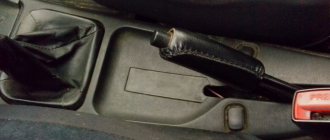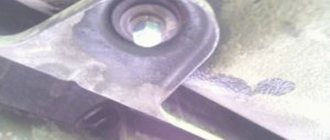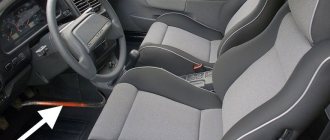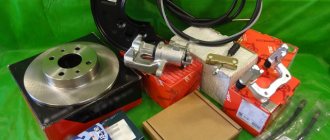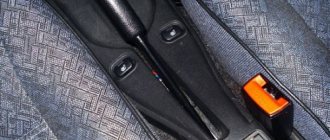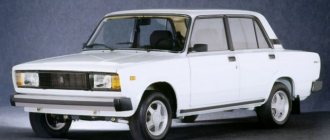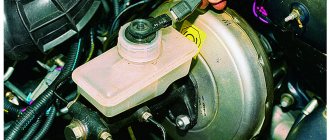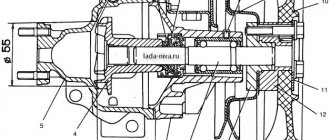How to bleed the brakes on a VAZ-2115 with your own hands
Most often, it is necessary to bleed the brakes in different cars, including the VAZ-2114, after the brake fluid has been replaced. Air can also get into the brake system when replacing any unit. If there is air, the system is unable to function normally. A sign of the presence of air in the system is the “pushing” of the pedal when you press it. Moreover, if you press the pedal several times in a row, it returns to its normal position. If you are faced with such a situation, you should find out how to properly bleed the brakes on a VAZ-2114. By following certain rules, you will be able to complete this procedure quickly and without any problems.
Preparatory stage
If you decide to bleed the brakes yourself, it is important to know that when bleeding you must use the same brake fluid as the one in the system.
No other liquid can be used. You must first check the tightness of the system. To level up you need one more person. You will also need a hose of a suitable diameter for the bleeder fitting, a glass or plastic container (transparent), a wrench and a rag for cleaning the caps.
It is very important to know in what order to remove air from the brake system. This procedure must be carried out diagonally, alternating the rear and front brakes:
- rear right;
- front left;
- rear left;
- front right.
Sequencing
First you need to open the hood of the car and open the cap of the brake fluid reservoir. Make sure it is filled to the maximum. If not, add to about. After this, follow the steps in the following sequence:
- On the rear right wheel, find the cap that covers the fitting. Remove the cap and clean it of dirt.
- Fill a clear glass or plastic container with brake fluid.
- Place one end of the hose onto the fitting and place the other end into a glass or transparent plastic bottle. The hose must be lowered into the liquid.
- Ask your partner to sit behind the wheel and gently press the brake pedal 7 times with breaks of 2 seconds. After this, he must press the pedal again and leave it in this position (pressed all the way).
- While an assistant holds the pedal, use a wrench to unscrew the fitting 2-3 turns.
After all these steps, you will see that brake fluid will flow into a transparent container through the hose. Watch how it drains.
There will be visible air bubbles in it that need to be removed. Drain the liquid until the bubbles disappear. Then screw the fitting back on. Only after this can your assistant release the pedal. When the liquid flows into the container, monitor its level in the tank. If necessary, add brake fluid. If during pumping it completely leaks out, you will have to start the whole procedure from the beginning.
Repeat similar steps for each wheel in the above sequence. This mechanism of action is suitable not only for the VAZ-2114, but also for models 2113, 2115.
Many car owners are wondering: is it possible to carry out pumping alone? Yes it is possible. Only in this case, the pressure should be produced not by pressing the pedal, but by using a powerful compressor for these purposes. It should create a pressure of 2 atmospheres.
Car owners have to carry out pumping in different situations. Air can enter when replacing copper pipes at the rear or other components of the brake system, when hoses are damaged, when replacing brake fluid, or if the seal in the unit is broken. Regardless of the reason, after air enters the GTZ (brake master cylinder), bleeding must be carried out. Otherwise, the brake simply will not work.
Bleeding brakes, braking system VAZ 2114, VAZ 2115, VAZ 2113, Lada Samara 2
Bleeding the brakes of the Lada Samara 2 is necessary to remove air from the hydraulic drive, which significantly reduces the efficiency of the service brake system. Air can enter the hydraulic drive due to depressurization of the system during repair or replacement of individual components, as well as when replacing brake fluid. The presence of air in the brake drive is indicated by increased travel of the brake pedal and its “softness”.
NOTE It is not recommended to use fluid drained from the system to fill the reservoir, as it is saturated with air, moisture and possibly contaminated.
Before removing air from the brake system of the Lada Samara 2, make sure that all brake drive units and their connections are tight, clean the lid and the surface around the reservoir cap, and fill the reservoir with brake fluid to the “MAX” mark. Then thoroughly clean the bleeder fittings and remove their protective caps. Air from the system is removed first from one circuit, then from the other, starting with the wheel cylinders of the rear brakes of the VAZ 2115.
Removing air from the hydraulic brake drive: 1 – bleeder fitting; 2 – hose; 3 – vessel with liquid
Place a rubber hose 2 onto the head of fitting 1 to drain the liquid, and lower its free end into a transparent container 3 partially filled with liquid. Pressing the brake pedal sharply 3–5 times at intervals of 2–3 s, unscrew the fitting 1/2–3/4 turn while the pedal is pressed. Continuing to press the pedal, displace the liquid in the system along with the air through the hose into the container. After the brake pedal reaches the forward extreme position and the flow of fluid through the hose stops, tighten the air release fitting as far as it will go. Repeat these operations until bubbles stop coming out of the hose. Keeping the pedal pressed, tighten the fitting as far as it will go and remove the hose. Wipe the fitting dry and put on the protective cap. Repeat the operations for other wheels, first on the second wheel of the same circuit, and then sequentially on both wheels of the other circuit. When removing air, make sure that there is liquid in the tank, avoiding exposing its bottom, as this will allow air to enter the system again. If there is no air in the brake drive, the brake pedal should go through 1/2 of its full travel. To eliminate the effect of the vacuum booster on bleeding the brakes, remove air with the Lada Samara 2 engine not running.
Preparation
The first sign that there is air in the system is when the pedal that activates the brake becomes depressed. Moreover, if you press and release it several times, it falls into place. Of course, with such unstable operation of one of the most important elements of a car in terms of safety, it is dangerous to go outside. Therefore, we recommend starting pumping immediately.
Please note that the described symptom may also indicate other breakdowns. This is about:
- an excessively large gap formed between the piston of the main cylinder and the bolt that regulates the operation of the vacuum booster;
- liquid leakage due to depressurization of communications;
- damage to the rear cylinder thrust ring (it usually fails).
Each of these problems needs to be addressed as a priority. Only after this does it make sense to start pumping.
There is one more important circumstance. Be sure to only use the brand of brake fluid that is already in the system.
It is advisable to involve an assistant in the work, so pumping is done faster and with less labor. We will tell you below what to do if you couldn’t find a partner.
- a transparent jar or plastic bottle with a capacity of 1.5 liters;
- flexible tube (rubber, silicone, etc.);
- a set of keys;
- clean rags.
It should also be understood that air is removed from the VAZ-2115 system in a certain order. First, the procedure is performed for the rear wheel (for example, the right one), and then the front one (respectively, the left one). That is, you need to act diagonally.
Sequencing
First you need to open the hood of the car and open the cap of the brake fluid reservoir. Make sure it is filled to the maximum. If not, add to about. After this, follow the steps in the following sequence:
- On the rear right wheel, find the cap that covers the fitting. Remove the cap and clean it of dirt.
- Fill a clear glass or plastic container with brake fluid.
- Place one end of the hose onto the fitting and place the other end into a glass or transparent plastic bottle. The hose must be lowered into the liquid.
- Ask your partner to sit behind the wheel and gently press the brake pedal 7 times with breaks of 2 seconds. After this, he must press the pedal again and leave it in this position (pressed all the way).
- While an assistant holds the pedal, use a wrench to unscrew the fitting 2-3 turns.
After all these steps, you will see that brake fluid will flow into a transparent container through the hose. Watch how it drains.
There will be visible air bubbles in it that need to be removed. Drain the liquid until the bubbles disappear. Then screw the fitting back on. Only after this can your assistant release the pedal. When the liquid flows into the container, monitor its level in the tank. If necessary, add brake fluid. If during pumping it completely leaks out, you will have to start the whole procedure from the beginning.
Features of work on models starting from VAZ-2108
Now let’s look at the specifics of the operation on other cars of the VAZ family. Starting with model 2108, the circuit diagram has changed, and therefore the sequence is somewhat different. And you need to know it before bleeding the brakes on the VAZ-2108, 2109, 21099.
These cars already use a diagonal arrangement of contours. That is, one of them combines the rear left and front right wheels, and the second - the other two.
Bleeding begins, as usual, from the farthest wheel, that is, from the rear right one. An operation to remove air from its brake mechanism is carried out according to the described sequence.
But there is one caveat. The design includes a pressure regulator for the rear wheel drive mechanisms. If the rear of the car is hung out before bleeding, this regulator must be unlocked. To do this, just install a screwdriver between the regulator rod and the thrust plate.
After all work it should be removed.
Then it is pumped to the second rear wheel, and the front left one, since it is the one that is combined with the circuit with the already pumped rear mechanism.
After pumping each mechanism, it is necessary to check the level in the tank. If you omit this point, then during operation the liquid will go into the system and air will enter it again.
Where did the air come from?
Air in the brake system may appear for the following reasons:
- Got in while changing brake fluid (How to change brake fluid?).
- Got it when replacing any brake elements, for example when replacing a brake cylinder (How to replace a rear brake cylinder?).
- Air may also appear due to a leak in the brake system, for example, cracked brake fluid pipes that need to be replaced immediately.
- The rear brake cylinder is leaking.
- The front brake cylinder is leaking.
- A leaky GTZ (brake master cylinder) can also be a problem.
Important: Over time, water gets into the brake fluid, as evidenced by its darkening. In this case, you need to replace the brake fluid. And in general, it is recommended every three years or 45 thousand km. mileage, change the brake fluid, because One way or another, condensation accumulates in it.
Also, prevent brake fluid from getting on the car body, otherwise it will easily wash away the paint to bare metal.
Bleeding brakes on VAZ 2113, VAZ 2114, VAZ 2115
Welcome! Bleeding the brakes is the most important part after replacing any unit in the brake system, or even after replacing the brake fluid itself with a new one. This procedure must be carried out in the cases described above, that is, after replacing something in the brake system itself, if you neglect this procedure, then you will have air in the brake system due to which you will not be able to simply brake , and in the literal sense of the word, your brakes will not work, but the pedal will simply move when you press it and when you release it and that’s it, so it’s necessary to pump the brakes.
But not in all cases, your brakes will not work at all; generally, this only happens after replacing the brake fluid with a new one, that is, if you only replace any brake caliper (for example, the right one), then after all this you will not have Only the right brakes on the front wheel of the car will work, and all the others, including the rear ones, will work!
Note! To bleed the brake system, you will need to stock up on: Firstly, an ordinary small about one liter bottle, which must be transparent, as well as a small hose which will be inserted into this bottle with one end and the other will be put on the fitting for bleeding, so choose the thickness of the hose strictly along the neck of the bottle and at this very fitting (What kind of fitting we are talking about, you will find out in more detail in this article but a little lower), and you will also need to stock up on new brake fluid, preferably of the same brand, if you are not going to change it, as well as a wrench or a spanner, and an inspection hole or a lift!
Summary:
When should you bleed your brakes? They must be pumped in all cases, as mentioned earlier, after replacing any part or the fluid itself in the brake system, because when replacing, air enters the system and the car will not brake after that.
But air can also get in for other reasons, for example, when the brake system depressurizes, which can happen when any brake hose bursts, as well as when the master or working brake cylinder is deformed, due to which air enters the system and will not allow you to stop the car normally.
Preparation for work
First of all, disconnect the sensor connector and secure this connector next to the tank. Then open the lid and add liquid to the MAX mark. This requires DOT-4 fluid .
Level sensor connector
On any car, including the VAZ-2114, the brakes are pumped with the lid closed. This means we tighten the lid harder, and then roll the car onto an overpass or pit.
If a lift is used, it means that when bleeding the rear cylinders, a spline is placed in the regulator (sorcerer).
Pressure regulator (sorcerer)
The screwdriver here is between the bracket and the rod. When bleeding the front brakes, remove the screwdriver.
Safety precautions: the handbrake must be engaged and the ignition key must be removed.
Correctly pumping the brakes on a VAZ-2114: order and sequence of actions
If when you press the brake pedal it fails, and after several presses everything returns to normal, it means there is air in the system . He needs to be kicked out, that is, pumped up. On the VAZ-2114 hatchback, you need to pump the brakes “diagonally”: start from the rear left wheel, move to the front right, etc. Also, if the rear axle is suspended, then install a screwdriver between the pressure regulator and the bracket.
We study the design of the brake system - watch the video.
Preparation for work
First of all, disconnect the sensor connector and secure this connector next to the tank. Then open the lid and add liquid to the MAX mark. This requires DOT-4 fluid .
Level sensor connector
On any car, including the VAZ-2114, the brakes are pumped with the lid closed. This means we tighten the lid harder, and then roll the car onto an overpass or pit.
If a lift is used, it means that when bleeding the rear cylinders, a spline is placed in the regulator (sorcerer).
Pressure regulator (sorcerer)
The screwdriver here is between the bracket and the rod. When bleeding the front brakes, remove the screwdriver.
Safety precautions: the handbrake must be engaged and the ignition key must be removed.
Sequence and correct procedure for pumping brakes on a VAZ-2114
- We find a fitting on the rear wheel drum (photo 1). It is usually closed with a cap that is removed. Place a hose on the fitting.
Rear brake cylinders
Bleeding the front cylinders
Possible sequence for pumping brakes for a VAZ-2114: rear right wheel, front left, rear left, etc. Each circuit is pumped starting from the rear wheel.
Articles
- 2101-1602591 – rear cylinder fitting;
- 2101-1602591-01 – disc brake fitting;
- 2101-1602592 – fitting cap.
How to bleed the brakes alone?
It seems that one person can bleed the brakes. But then you need to increase the pressure in the tank. The source of air will be the tires. By the way, the limiting value should be considered 2 atmospheres.
The cap with the nipple is screwed onto the neck of the tank. Next, the “extension cord” is assembled. The donor wheel is hung out when bleeding the brakes.
You can open the fittings one by one and drain the liquid. But you also need to monitor the fluid level in the tank.
Topping up is done as follows: disconnect the “extension cord” from the tire, unscrew the cap, etc.
Instructions for the last chapter in one video
Yes, as on most cars, bleeding is done crosswise, but I would advise changing the old brake hoses, pads and brake fluid for a brake system that does not fail. It’s better to spend money once and forget about the brakes than to constantly crawl under the car.
Pumping is not difficult, call an assistant and pump them according to the instructions in the manual. Just keep an eye on the brake fluid level when bleeding. After bleeding, drive off with caution. Until the pedal becomes hard and the pads are in place.
When is pumping required and how to prepare for it
Bleeding the brakes is not always necessary - if the brake system is functioning properly, then bleeding is not necessary.
It is required only in the following three situations:
- When the pedal begins to “fail” (as was mentioned at the very beginning of the article).
- After replacing any component of the brake system.
- After replacing the fluid.
All these situations are caused by one single reason - air entering the system. So, if the pedal began to “fall” by itself, then, most likely, the brake tract was depressurized in some area, and air leaked inside.
When replacing parts, air also enters the brake system in large quantities and remains inside, causing its failure (the same applies to a complete replacement of the brake fluid).
It is important to note that it is highly advisable (or, more correctly, mandatory) to do bleeding immediately after repairing the brakes or replacing the fluid, without driving a “not pumped” car - after all, this can pose a more than real threat to life.
A mandatory condition that should always be observed is the order of bleeding the brakes of the VAZ 2114. So, the left rear wheel is pumped first, followed by the right front, then the right rear and then the front left.
In preparation for bleeding the brakes, you need to perform the following preparatory work:
- install the car on the handbrake;
- disconnect the liquid level sensor connector from the tank and secure it;
- open the tank lid;
- add brake fluid to the maximum level (MAX mark);
- insert a slotted screwdriver into the rear adjuster between the rod and the bracket (this should only be done when bleeding the rear brakes; when starting to bleed the front brakes, it should be removed).
Bleeding brakes on a VAZ 2110
The brake system is a very important component of any car, regardless of its brand and other characteristics. Malfunctions of the brake system are one of the common troubles that arise every now and then during the operation of a car. However, in most cases they can be avoided if preventive measures are taken in time.
Why do you need to bleed the brakes?
Thus, one of the most common measures to prevent and ensure the stability of the brake system is bleeding the brakes. The essence of this event is to remove “excess” air and foreign liquids from the system. There may be several prerequisites for the appearance of “foreign” substances in the brake system:
- spare parts were replaced in the unit,
- violation of the integrity of the hoses,
- use of low-quality brake fluid, etc.
In addition, it should be understood that brake fluid has the property of being hygroscopic, that is, it has the ability to accumulate water. For this reason, sooner or later the liquid must be drained and the system, accordingly, must be pumped. Replacing brake discs with your own hands, by the way, also entails the need for bleeding, just like any other intervention in the brake system.
Bleeding the brakes
If you have done all of the above, then it is time to move on to the main work. By adding oil and dealing with the rear brake problem, you have only prepared your VAZ 2115 for bleeding.
After this, the entire brake system must be thoroughly cleaned. The most important thing is that the air release valve is in perfect condition, otherwise it will not be possible to bleed the brake system. In any case, it can be replaced, but it will take a lot of time. If everything is in order with the car, then feel free to remove the protective cap from the valve.
Now you need to insert one end of the hose into the valve
, and place the other in a container with brake fluid. The most important thing is that the end of the hose is accurately immersed in the brake fluid, and not just hanging on it. After this, you just need an assistant. His task will be to press the brake pedal. You need to do this about five times, and then hold the pedal down constantly.

